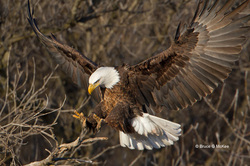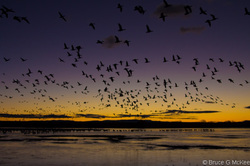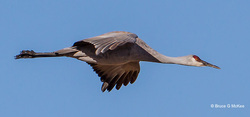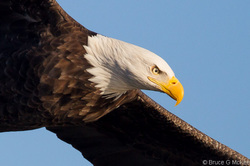
(There are more Eagle photos here and here.)
 Click for a larger image of the Eagle landing. It was a cold January afternoon last Monday, +3 degrees F and a 20 MPH wind blowing. I sat in the car by the river with the window open, and my lens out the window, watching two eagles come and go, perching in the same tree. They sat nearly motionless for many minutes at a time, only occasionally turning their head to gaze in to the river below or to keep an eye on the hundreds of Canada Geese and Mallards in a patch of open water. One Eagle would fly away, be gone for a while, then the other would leave, perhaps just taking a fly around and then returning to the same branch. I had hoped to get photos of them catching a fish in the river or feeding on the frozen half-eaten fish carcass that was laying on the ice below. No such luck. I waited for nearly three hours (did I mention that the window was open?) and my hands and feet were getting a bit numb. I did get a few photos of perching and flying, and even a yearling deer tiptoeing through the geese in the river to get to the other side, but not the photos I had hoped for. I thought several times that since nothing was happening I should leave, and the late afternoon sun was starting to cast long shadows. I was losing my light. Then as I watched, one Eagle leaned his (or her?) head forward, clearly focused on one spot in the river, and slightly lifted his tail feathers. I knew he was about to fly. I focused on the bird and started taking a burst of pictures as he left the branch and headed to the open water below. He stretched out his talons, spread his wings to control his descent just before he got to the water, and... splash! He apparently misjudged, because he crashed in to the water, nearly up to his neck. He flopped his now wet wings a couple of times and was able to hoist himself out of the water on to the nearby ice where he looked around over each shoulder as if to see if anyone was watching. He shook himself off and flew back up in to the tree to dry out his feathers in what was left of the afternoon sun. An exciting end to my afternoon Eagle watch. (There are more Eagle photos here and here.) Click each to see a larger image.
2 Comments
 Click for more Snow Geese photos The last week of December we stopped for a short time at the Bosque del Apache National Wildlife Refuge south of Albuquerque, New Mexico to see and photograph the spectacle of the pre-sunrise "blast off" of thousands of Snow Geese and to photograph Sandhill Cranes. (My blog posts aren't chronological. I share a few photos when I get around to editing them.) We arrived in the dark, and set up our cameras and tripods along with dozens of other photographers as the sky was just starting to get some light on the horizon. Then we waited. The Snow Geese and Sandhill Cranes roost in the ponds over night and at some time before sunrise (no one knows when) there is some signal among the geese and all at once they "blast off" heading to nearby fields to feed during the day. The whole event lasts about 25 seconds so you need to be ready to take pictures in a split second (see the video below). It is quite a sight.  Click for more Sandhill Crane photos Meanwhile the Sandhill Cranes, also roosting with the geese, could seemingly care less. Many never taking their head out from under their wing to see what the commotion is all about. The cranes take their time waking up and gradually in small flocks fly off to the fields to feed. They are majestic birds, almost prehistoric (I may have made the same comment about Great Blue Herons). We drove around the refuge and found several places where we could photograph the cranes and geese flying and feeding. [More...] Video of thousands of Snow Geese at Bosque del Apache National Wildlife Refuge:
 Click for more Eagle pictures It was a great day of taking Eagle pictures at Lock and Dam 14 on the Mississippi River near LeClaire, IA (near Bettendorf and Davenport). This is undoubtedly one of the better places to photograph Eagles in the lower 48 states. People come from all over the country. I have been there the first week of March, the end of February, and this year the first week of January. This week was by far the best with the most Eagles. At one point I counted close to 50 either perching in trees (12 in one tree), flying over the dam or catching fish in the river. There were also about 70 photographers lined up shoulder to shoulder - lots of big lenses. This is an odd spot in the river because it isn't North-South, but turns to the Southwest. So it takes the sun a long time to get around to the best lighting position for taking photos of the flying birds. Generally, at this time of year, from about 1:00 PM until 3:30 PM is the best time. Earlier, there are a lot of shadows; later and the sun is below the trees on the West side of the river. However, to get a good parking spot and position for tripod set up you may want to get there earlier. Telephoto or long zoom lenses are a must for getting close-up pictures and a fast shutter speed to stop the action. Some photographers hand-held their cameras and others used a tripod. You need to be able to pan quickly as the birds are flying. Watch the weather when planning your trip. It seems like the colder the better. If much of the river is frozen over the Eagles will concentrate below the dam. The best conditions are a bright sunny day with the wind coming from the West-Southwest or from the Southwest. The Eagles will fly in to the wind as they swoop down to grab a fish from the river and this will put them facing toward the sun or with the sun slightly to their right, and facing the right direction for photography from the viewing platform. At some times the action is very fast with several Eagles fishing at the same time. At other times you may sit for a long time with no action. Bring a stool or you'll be standing a long time. I had a good day photographing Bald Eagles and got many shots that I liked. I especially liked the one below of the Eagle looking at the fish that he had just snared. You can see more Eagle pictures here. Getting there: Take I-80 to the Le Claire, IA exit just before the bridge crosses the river to Illinois. It is exit 308. Go south on US Highway 67 (S. Cody Rd) for a couple of miles and turn left (East) in to a drive for the Lock and Dam 14. There is a large parking area below the lock next to the river and a long paved sidewalk for viewing and photography. |
Bruce's Blog
Just a few notes about my photos and videos. See more on Facebook. and videos on YouTube Archives
March 2024
Categories
All
|
All photographs © Bruce G. McKee - May not be reproduced without written permission - All rights reserved